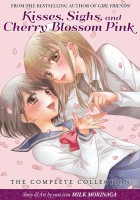 Creator: Milk Morinaga
Creator: Milk Morinaga
U.S. publisher: Seven Seas
ISBN: 9781937867317
Released: June 2013
Original release: 2012
Kisses, Sighs, and Cherry Blossom Pink is the second yuri manga by Milk Morinaga to have been licensed in English. The first, and my introduction to her work, was her series Girl Friends. I quite enjoyed Girl Friends and so was looking forward to reading more of her manga, in this case one of her earlier series. Kisses, Sighs, and Cherry Blossom Pink was released in English by Seven Seas in 2013 in a single-volume omnibus edition. Morinaga first began creating the stories included in Kisses, Sighs, and Cherry Blossom Pink in 2003. In Japan, the earlier stories were collected into a single volume in 2006. However, Kisses, Sighs, and Cherry Blossom Pink was later released again in 2012 in two volumes that collected additional stories, including some that were previously unpublished. This two-volume edition of Kisses, Sighs and Cherry Blossom Pink is the one upon which Seven Seas’ omnibus is based. As such, the English-language edition of the manga collects nearly a decade’s worth of material into a single volume.
Nana and Hitomi were best friends who grew up together and attended the same elementary and junior high schools. Nana was looking forward to becoming a student at Sakurakai Girls’ High School, but that was when she thought Hitomi would be enrolling as well. However, Hitomi was accepted at Touhou Girls’ High School. Finding it too painful to continue to suppress her love for Nana after being rejected, Hitomi chooses to attend Touhou instead. Despite how close the two of them used to be, Nana finds Hitomi drifting away and she misses her terribly. But recognizing her own feelings is only the first step in mending their relationship as is begins to evolve into something more than just friendship. Similarly, several of the other young women at Sakurakai and Touhou are faced with their own first loves and crushes on classmates. It isn’t always easy to confess their feelings and falling in love with a person of the same gender often brings along challenges that other couples don’t have to deal with.
The stories collected in Kisses, Sighs, and Cherry Blossom Pink follow a vague chronological order, but many of them aren’t directly related to one another. They share the same setting and to some extent the same characters, but only Nana and Hitomi are the focus of multiple stories in the volume. I actually really enjoyed Morinaga’s structural approach to Kisses, Sighs, and Cherry Blossom Pink. Nana and Hitomi’s relationship provides a more developed, ongoing narrative, creating a framework which supports the supplementary side stories about their classmates and friends. Overall, I feel this gives the manga slightly more depth. Also included in Kisses, Sighs, and Cherry Blossom Pink is a diagram that visually shows how all of the different stories and characters overlap and are connected to one another. Although they are interrelated and occasionally make references to previous developments and chapters, most of the stories do stand perfectly well on their own in addition to contributing to the manga as a whole.
Kisses, Sighs, and Cherry Blossom Pink tends to be very cute, sweet, and romantic, which is not to say that every story is a happy one. I appreciated that some of the chapters in Kisses, Sighs, and Cherry Blossom Pink have touches of angst, sadness, and bittersweetness to them. Nana and Hitomi’s relationship, despite having its ups and downs, does have an ending that seems to tie everything up a little too easily and nicely, but I won’t deny that it made me smile. Morinaga also addresses some very real issues and concerns, such as homophobia, that are encountered by same-gendered couples, but many of the feelings expressed are relevant for any romantic relationship. The manga may be a bit melodramatic at times, but it is emotionally resonant. Kisses, Sighs, and Cherry Blossom Pink also incorporates a fair amount of humor. It’s a highly enjoyable and charming collection of short manga with likeable characters, a generally optimistic outlook, and a satisfying amount of realism to go along with its sweetness.














